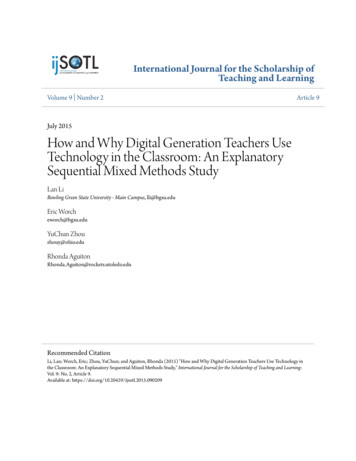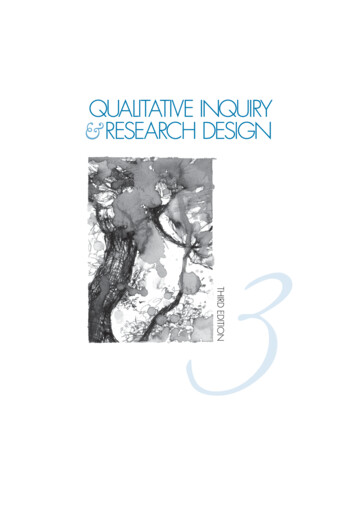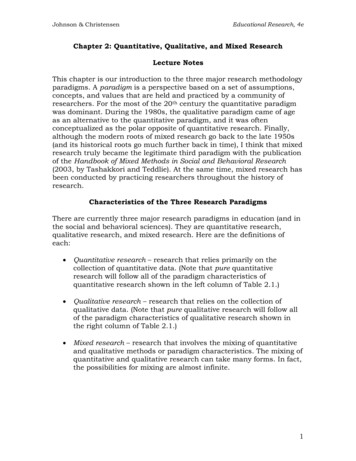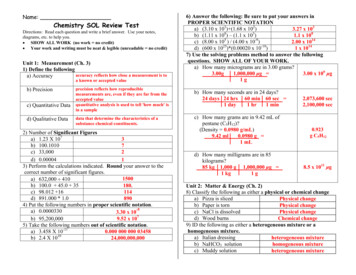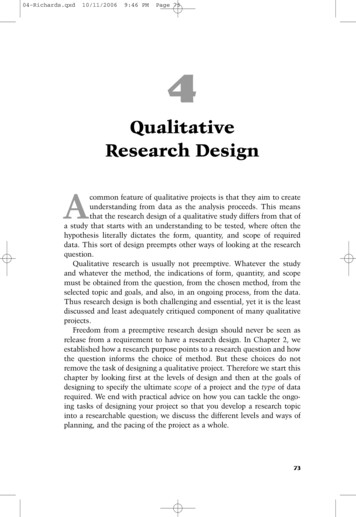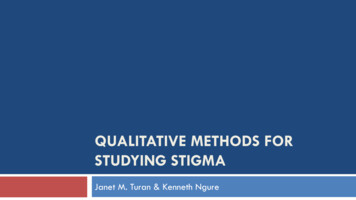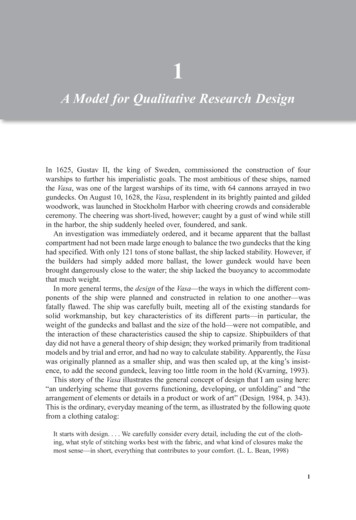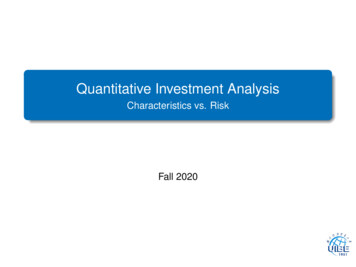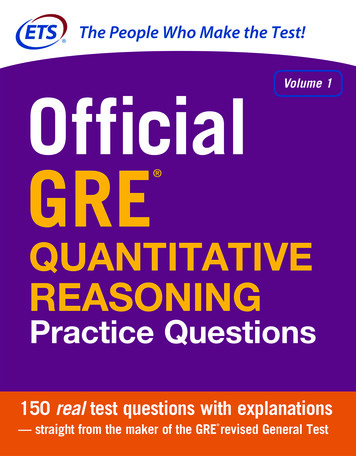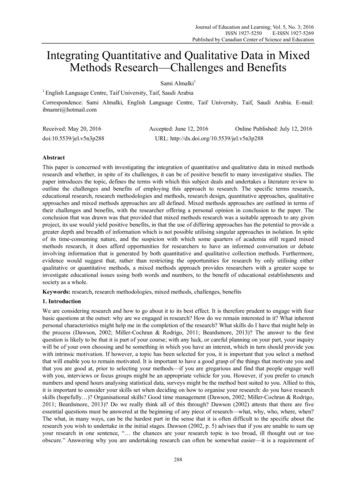
Transcription
Journal of Education and Learning; Vol. 5, No. 3; 2016E-ISSN 1927-5269ISSN 1927-5250Published by Canadian Center of Science and EducationIntegrating Quantitative and Qualitative Data in MixedMethods Research—Challenges and BenefitsSami Almalki11English Language Centre, Taif University, Taif, Saudi ArabiaCorrespondence: Sami Almalki, English Language Centre, Taif University, Taif, Saudi Arabia. E-mail:ibnamri@hotmail.comReceived: May 20, 2016doi:10.5539/jel.v5n3p288Accepted: June 12, 2016Online Published: July 12, 2016URL: http://dx.doi.org/10.5539/jel.v5n3p288AbstractThis paper is concerned with investigating the integration of quantitative and qualitative data in mixed methodsresearch and whether, in spite of its challenges, it can be of positive benefit to many investigative studies. Thepaper introduces the topic, defines the terms with which this subject deals and undertakes a literature review tooutline the challenges and benefits of employing this approach to research. The specific terms research,educational research, research methodologies and methods, research design, quantitative approaches, qualitativeapproaches and mixed methods approaches are all defined. Mixed methods approaches are outlined in terms oftheir challenges and benefits, with the researcher offering a personal opinion in conclusion to the paper. Theconclusion that was drawn was that provided that mixed methods research was a suitable approach to any givenproject, its use would yield positive benefits, in that the use of differing approaches has the potential to provide agreater depth and breadth of information which is not possible utilising singular approaches in isolation. In spiteof its time-consuming nature, and the suspicion with which some quarters of academia still regard mixedmethods research, it does afford opportunities for researchers to have an informed conversation or debateinvolving information that is generated by both quantitative and qualitative collection methods. Furthermore,evidence would suggest that, rather than restricting the opportunities for research by only utilising eitherqualitative or quantitative methods, a mixed methods approach provides researchers with a greater scope toinvestigate educational issues using both words and numbers, to the benefit of educational establishments andsociety as a whole.Keywords: research, research methodologies, mixed methods, challenges, benefits1. IntroductionWe are considering research and how to go about it to its best effect. It is therefore prudent to engage with fourbasic questions at the outset: why are we engaged in research? How do we remain interested in it? What inherentpersonal characteristics might help me in the completion of the research? What skills do I have that might help inthe process (Dawson, 2002; Miller-Cochran & Rodrigo, 2011; Beardsmore, 2013)? The answer to the firstquestion is likely to be that it is part of your course; with any luck, or careful planning on your part, your inquirywill be of your own choosing and be something in which you have an interest, which in turn should provide youwith intrinsic motivation. If however, a topic has been selected for you, it is important that you select a methodthat will enable you to remain motivated. It is important to have a good grasp of the things that motivate you andthat you are good at, prior to selecting your methods—if you are gregarious and find that people engage wellwith you, interviews or focus groups might be an appropriate vehicle for you. However, if you prefer to crunchnumbers and spend hours analysing statistical data, surveys might be the method best suited to you. Allied to this,it is important to consider your skills set when deciding on how to organise your research: do you have researchskills (hopefully )? Organisational skills? Good time management (Dawson, 2002; Miller-Cochran & Rodrigo,2011; Beardsmore, 2013)? Do we really think all of this through? Dawson (2002) attests that there are fiveessential questions must be answered at the beginning of any piece of research—what, why, who, where, when?The what, in many ways, can be the hardest part in the sense that it is often difficult to the specific about theresearch you wish to undertake in the initial stages. Dawson (2002, p. 5) advises that if you are unable to sum upyour research in one sentence, “ the chances are your research topic is too broad, ill thought out or tooobscure.” Answering why you are undertaking research can often be somewhat easier—it is a requirement of288
www.ccsenet.org/jelJournal of Education and LearningVol. 5, No. 3; 2016your course, it is something that your employers wishing to do, it might be something of interest to you (Dawson,2002) or a combination of all three. It is critical for the success of any research that you are aware of why youare conducting an inquiry, as it will have an effect on the way in which you administer your research and reportyour findings (Dawson, 2002). The third question, who, requires any researcher to identify those who willpotentially participate in their study. It is important that you have a grasp on the type of people who will need tobe targeted, in order to generate the information required to answer the central question of your study. Where,concerns itself with the location of your investigation which will be dependent upon, to some extent, your budgetand the time that you have available to complete your study. It is important that you find a venue that is suitableso that the participants feel comfortable and that they are contributing to a worthwhile project (Dawson, 2002).The final question, when, covers the timescale for the conduct of your project. Consideration needs to be madeof the proposed participants, particularly if you are intending to conduct interviews, asking them to completequestionnaires and/or observing them (Dawson, 2002).It is of great comfort that Willig (2013) suggests that there are no right and wrong means of going aboutconducting a piece of research. However, it is critical that researchers are able to pinpoint what they are doingand why, with whom, where and when they are undertaking a specific inquiry. To that end, my “what” today isto investigate the integration of quantitative and qualitative data in mixed methods research, with the hypothesisthat, in spite of its challenges, it is of positive benefit to many studies. “Why”—because I have to, but fortunately,it is a subject in which I have considerable interest. “Who” is a simple one in this instance, in that thisinvestigation will be in the form of a literature review which I will be presenting to you today. The questions of“where” and “when” are also straightforward in that they have already been done; the literature review wasconducted across a variety of media platforms, including library based research utilising texts, and onlineresources accessed via the Internet over the course of the last month. In the first instance, I will be defining theterms which will be covered as a part of the literature review in order that I, as the presenter, and you, as theaudience, have some form of agreed understanding about the topic at hand. Following this, there will be adiscussion of the reasons behind conducting a Mixed Methods approach to research, covering both its challengesand its benefits, concluding with an assessment of whether my hypothesis has been proven.2. Definition of Terms2.1 ResearchResearch has a number of different definitions as a result of there being more than one type. It can be regarded as“studious inquiry or examination investigation or experimentation aimed at the discovery and interpretation offacts, revision of accepted theories or laws in the light of new facts, or practical applications of such new orrevised theories or laws” Merriam-Webster Online Dictionary (2010).Thomas et al. (2011, p. 3; endorsed by Tuckman & Harper, 2012) state that it is “a careful and systematic meansof solving problems” and gaining new knowledge (Bhattacharyya, 2006), with Mouly (1978, p. 12) suggestingthat it is best regarded as being“ the process of arriving at dependable solutions to problems through the planned and systematic collection,analysis and interpretation of data.”Gratton and Jones (2010, p. 4; echoed by Godddard & Melville, 2001; Brink et al., 2006) define research asbeing “ a systematic process of discovery and advancement of human knowledge,” which Kumar (2008)believes should make some form of innovative contribution to existing knowledge or in solving a problem.2.2 Educational ResearchEducational research can be described as “ critical enquiry aimed at informing educational judgements anddecisions in order to improve action” (Bassey, 1999; cited in Foreman-Peck & Winch, 2010, p. 8) which isconducted carefully and systematically (Picciano, 2004). It is the gathering and evaluation of data within theeducational world, in order to understand and to make improvements to it (Opie, 2004). Educational researchcovers a wide spectrum of things from the administration and structure of education, to issues of equality andsocial justice, the curriculum, assessment, special educational needs, creativity and the impact of education onthe economy (Gardner, 2011). It is driven by the need to improve provision and to have a positive impact onboth individual learners and society as a whole (Reiss et al., 2010) through informing all stakeholders includingthe government, practitioners and parents (Gardner, 2011). The British Educational Research Association[BERA] (2013) believes that educational research should support the development of education in the future, aswell as highlighting what works at the present time (endorsed by Whitty, 2006; Wallen & Fraenkel, 2011; James,2012), which concurs with the ideas of Newby (2013) who believes that there are three reasons for engaging in289
www.ccsenet.org/jelJournal of Education and LearningVol. 5, No. 3; 2016educational research—to explore current and potential issues, to influence policy decisions, and to evaluate andprogress classroom practice.3. Research Methodologies and MethodsRajasekar et al. (2013, p. 5) describe research methodology as “ the procedures by which researchers go abouttheir work of describing, explaining and predicting phenomena”.A methodology provides a piece of research with its philosophy, the values and assumptions which drive therationale for the investigation as well as the standards that will be utilised for the interpretation information andthe drawing of conclusions (Bailey, 1994). It will provide the focus and approach for the study and is the processthrough which researchers pinpoint the methods that will be used in order to address their specific question(Crotty, 1998). The methodology will take an overview which considers the ethics, potential risks and problems,and the limitations of any approach (Dawson, 2002) and can be regarded as the discipline of applying (andunderstanding) appropriate methods and processes for specific pieces of research (Kaplan, 1973; cited in Cohenet al., 2007, p. 47; Kinash, n.d.). Kothari (2004; endorsed by Rajasekar et al., 2013) states that it is the science ofhow research project can be undertaken and describes the stages that researchers go through whilst they decideupon the best means of addressing their research problem, and the logic behind their reasoning.Research methods are the instruments and/or tools that researchers employ whilst they administer any form ofinquiry or investigation (Walliman, 2011; Bailey, 1994). There are a myriad of tools which can be utilised toadminister different enquiries (Walliman, 2011; Cohen et al., 2007) and it is the researcher’s responsibility toselect the most appropriate tool for their specific study (Wilkinson & Birmingham, 2002). Each of the toolsselected must compliment other, in order that the information that is generated is pertinent to the subject of thestudy and follow in a logical progression (Jonker & Pennink, 2010), although it is apposite to note, as mentionedearlier, that there is no right or wrong method for conducting a specific piece of research. However, it is essentialthat the method selected by each individual researcher for their project is one which is appropriate to the task, iscommensurate with their skills set and is one which has more strengths and less weaknesses (Tashakkori &Teddlie, 2010; Buchanan & Bryman, 2009; Wilkinson & Birmingham, 2003) than others that might have beenemployed.3.1 Research DesignHakim (2000, p. 1) observes that design is primarily concerned with “ aims, uses, purposes, intentions andplans within the practical constraint of location, time, money” and the availability of the researcher. She alsocomments that any research design will also be a reflection upon a researcher’s ideas although, in order to besuccessful, the investigator must address three critical questions when engaged in this process (Creswell, 2003).Creswell (2014) believes that researchers must question themselves about the knowledge claims and theoreticalperspectives that they are bringing to any research, they must reflect upon the strategies they intend to use withintheir study which will in turn inform their methods, and have questioned how they will collect and analyseinformation. This must be done in order that researchers are cognisant of any bias that they might bring to anyresearch investigation, how it will affect the choice of approach that they utilise and the tools with which theychoose to collect their data (Vogt et al., 2012). Broadly speaking, there are three distinct approaches toconnecting research—quantitative, qualitative and mixed methods. Creswell (2014) considers research designs tobe different types of inquiry within these different approaches which Denzin and Lincoln (2011, cited inCreswell, 2014, p. 12) called “strategies of inquiry”. Furthermore, Creswell (2014) regards the development ofmodern technology as providing a multitude of opportunities for innovative research design and advancedprocedures in social sciences.3.2 Quantitative ApproachQuantitative research is regarded as a deductive approach towards research (Rovai et al., 2014). Quantitativeresearchers regard the world as being outside of themselves and that there is “ an objective reality independentof any observations” (Rovai et al., 2014, p. 4). They contend that by subdividing this reality into smaller,manageable pieces, for the purposes of study, that this reality can be understood. It is within these smallersubdivisions that observations can be made and that hypotheses can be tested and reproduced with regard to therelationships among variables. This approach is typified by the researcher putting forward a theory that isexemplified within a specific hypothesis, which is then put to the test; conclusions can then be drawn with regardto this hypothesis, following a series of observations and an analysis of data (Rovai et al., 2014). A feature ofthis approach towards research is that the collection and analysis of information is conducted utilizing “ mathematically based methods ” (Aliaga & Gunderson, 2000; cited in Muijs, 2011, p. 1) which focus upon290
www.ccsenet.org/jelJournal of Education and LearningVol. 5, No. 3; 2016“ polls, or surveys [focusing] on gathering numerical data and generalising it across groups of people”(Babbie, 2010; cited in University of Southern California, n.d., para 1; endorsed by Bryman, 1988; cited inBlaikie, 2010, p. 215; Harwell, n.d.).3.3 Qualitative ApproachQualitative research places emphasis upon exploring and understanding “ the meaning individuals or groupsascribe to a social or human problem” (Creswell, 2014, p. 4; echoed by Holliday, 2007). Denzin and Lincoln(2005) describes this approach as gaining a perspective of issues from investigating them in their own specificcontext and the meaning that individuals bring to them. It focuses upon drawing meaning from the experiencesand opinions of participants—it pinpoints “ meaning, purpose or reality” (paraphrase of Hiatt, 1986; inHarwell, n.d., p. 148; Cohen et al., 2011; Merriam, 2009). Qualitative methods are usually described as inductive,with the underlying assumptions being that reality is a social construct, that variables are difficult to measure,complex and interwoven, that there is a primacy of subject matter and that the data collected will consist of aninsider’s viewpoint (Rovai et al., 2014). Rovai et al. (2014, p. 4) make the point that this approach towardsresearch “ values individuality, culture, and social justice” which provides a content and context rich breadthof information which, although subjective in nature, is current (Tracy, 2013). Having said that, the employmentof qualitative approach methods does not prevent the administration of a critical, disciplined and balanced studyinto any educational issue (Thomas, 2009; Silverman, 2009; Bell, 2010).3.4 Mixed Methods Approach—A Literature Review3.4.1 Mixed Methods ResearchMixed methods research has been described in a variety of ways which can make it a difficult concept tounderstand (Niglas, 2009). It has been referenced as “empirical research that involves the collection and analysisof both qualitative and quantitative data” (Allan, n.d., Slide 4), whereas Burke Johnson et al. (2007, p. 123)define it as:“ the type of research in which a researcher or team of researchers combine elements of qualitative andquantitative research approaches (e.g., use of qualitative and quantitative viewpoints, data collection, analysis,inference techniques) for the broad purposes of breadth and depth of understanding and corroboration.”Greene (2007, p. xiii; endorsed by Johnson & Onwuegbuzie, 2004) believes that this approach providesresearchers with opportunities to “ compensate for inherent method weaknesses, on inherent method strengths,and offset inevitable method biases”. Creswell and Plano Clark (2011) comment that this approach enables agreater degree of understanding to be formulated than if a single approach were adopted to specific studies.Furthermore, they also put forward a collection of core characteristics which highlight key elements withinmixed methods research. They state that researchers collect and analyse both qualitative and quantitative data ina sequential and/or simultaneous and rigorous manner which integrates the two forms of data. The way in whichthis data is combined will depend upon the nature of the inquiry and the philosophical outlook of the personconducting the research.Greene et al. (1989) provide five distinct justifications for the integration of quantitative and qualitative researchdata. Triangulation provides opportunities for convergence and corroboration of results that are derived fromdifferent research methods. Complementarity “seeks elaboration, enhancement, illustration, clarification of theresults from one method with the results from another” (Greene et al., 1989, p. 259).Development sees researchers utilising the results from one method to inform another method which covers allaspects of the inquiry. Initiation involves the discoveries of contradictions or inconsistencies within the data setswhich can result in the reformulation of questions or additional questions being raised.I, as a researcher, share this worldview in that I believe it is far more important to focus on understanding anissue and finding solutions to problems than focusing upon specific methods or approaches.4. Challenges and BenefitsTo my mind, there are a number of distinct challenges that face any researcher who decides to embark uponutilising mixed methods for their research study. The first is that of skills - it is critical that researchers are awareof their skills sets and whether they are able to cope with the demands of utilising a mixed methods approach(Creswell & Plano Clark, 2011). The second, and in many ways the most pressing challenge, is that of decidingwhich mixed method research design is most appropriate for your particular study. This will depend upon whereyou feel your project lies on the continuum of research approaches—will your approach be purely mixed whichgives equal status to both quantitative and qualitative information or will it be dominated by one approach or the291
www.ccsenet.org/jelJournal of Education and LearningVol. 5, No. 3; 2016other (Burke Johnson et al., 2007)? In order to make sense of the multitude of mixed method research designs,Creswell and Plano Clark (2007) have synthesised these into four main typologies—the triangulation design, theembedded design, the explanatory design and the exploratory design.4.1 The Triangulation DesignFigure 1. The triangulation mixed methods design (Creswell & Clark, 2007)The triangulation design is one which seeks to gather complimentary yet distinctly different data on the sametopic which can then be integrated for analysis and interpretation. Allan (n.d., Slide 24) identifies the benefits ofthis model lying in its sensibility.Benefits: it makes intuitive sense to gather information from different sources, utilising different methods, whichwork together as an efficient design.Challenges: its lie in the considerable effort and expertise that is required to draw everything together and thepotential for further research and/or investigation being required as a result of discrepancies within the data sets.4.2 The Embedded DesignFigure 2. The embedded mixed methods design (Creswell & Plano Clark, 2007)The embedded design sees one method of enquiry being used in a supportive secondary role which enablesresearchers and readers to make sense of the study in its entirety.Benefits: it is that it requires less resources and produces less data which makes it an easier prospect forresearchers to tackle. This method is used in quantitative experimental designs where only a limited quantity ofqualitative data is necessary (Allan, n.d., Slide 25). Challenges: are that it can often be difficult to integrateresults, and that this approach is very difficult within qualitative research and that few examples exist fromwhich researchers can model their study.4.3 Explanatory DesignsFigure 3. Sequential mixed methods design (Creswell & Plano Clark, 2007)292
www.ccsenet.org/jelJournal of Education and LearningVol. 5, No. 3; 2016Explanatory designs are described as a two stage design which sees quantitative data being used as the basis onwhich to build and explain qualitative data. The quantitative data informs the qualitative data selection processwhich, to my mind, is a great strength in that it enables researchers to specifically pinpoint data that is relevant tospecific research project. Allan (n.d., Slide 26) points out that this design is commonly used in educationalresearch, being referred to as a participant selection model.Benefits: is that it is easy to implement and that it enables the focus of the research to be maintained, as a resultof one set of data building upon the other. Clearly, the challenge lies in the selection of participants in order thatpertinent information is available and the time consuming nature of this method of approach.4.4 The Exploratory DesignFigure 4. The exploratory mixed methods design (Creswell & Clark, 2007)The exploratory design is the reverse of the explanatory model, with the qualitative data in forming thequantitative information gathering process.Benefits: are that the separate stages are easy to implement and that the qualitative data is acceptable toquantitative researchers.Challenges: being its time-consuming nature and the risk that participants might not be willing/able toparticipate in both phases, as a result of the second phase not being planned well enough in advance (Allan, n.d.,Slide 27).Further challenges facing those who utilise mixed methods research are that of time and resources, and inconvincing others of its value (Creswell & Plano Clark, 2011).A further benefit of this method is the flexibility that this research design provides in answering importantquestions which Harwell (n.d., p. 160; endorsed by Bryman,) contends offers a “ promising path towards usingresearch design in ways that support rigorous examinations of promising educational ideas”.Moreover, Creswell and Plano Clark (2011) emphasised the fact that mixed methods studies may require a gooddeal of time, effort and resources on the part of researchers and it is important that they are aware of this,particularly if they are working alone. They also highlight the fact that some sections of academia object tomixed methods approaches on philosophical grounds, in that they believe it to be a conglomeration of differentattitudes which leaves them closed to the possibility of the veracity of mixed methods research. It is, in myopinion, also quite obvious that this method of approach is eminently practical, in that the researcher is affordedthe opportunity to address an issue through utilising numbers and words and approaching their study employingthe methods with which they feel most comfortable5. ConclusionIt would seem to me that mixed method research does provide positive benefits to research inquiries, providedthat this is a suitable approach towards a specific issue. Given that is the case, it provides opportunities forresearchers to forge “ an overall or negotiated account of the findings that brings together both components ofthe conversational debate” (Bryman, 2007, p. 21; cited in Rovai et al., 2014, p. 5). It is critical that, no matterwhich particular typology of mixed method research is employed, there is a purposeful and carefullyimplemented sequence to the study which is conscientiously documented and evaluated (Rovai et al., 2014). Iconcur with the opinions of Deacon et al. (1998, p. 61; cited in Allan, n.d., Slide 12) who state that “whatevershort-term inconvenience this may cause, in many cases the reappraisal and reanalysis required can reaplong-term analytical rewards: alerting the researcher to the possibility that issues are more multi-facted than theymay have initially supposed, and offering the opportunity to develop more convincing and robust socialexplanations of the social processes being investigated”.293
www.ccsenet.org/jelJournal of Education and LearningVol. 5, No. 3; 2016Mixed methods would appear to provide a realistic link between quantitative and qualitative studies, and indeed,those who conduct them. At the end of the day, as Creswell and Plano Clark (2014, p. 12) point out “we aresocial, behavioural, and human sciences researchers first, and divisions between quantitative and qualitativeresearch only served to narrow the approaches and the opportunities for collaboration.” It would seem churlish todeny the opportunities for researchers and society in general to have a greater understanding of the issues whichface education today, irrespective of whether discoveries are made as a result of qualitative, quantitative ormixed methods research.ReferencesAllan, A. (n.d.). Mixed Methods Research. Client supplied.Bailey, K. (1994). Methods of Social Research (4th ed.). New York: The Free Press.Beardsmore, C. (2013). How to Do Your Research Project: A Guide for Students in Medicine and HealthSciences. Chichester: John Wiley & Sons Ltd.Bell, J. (2010). Doing Your Research Project: A Guide for First Time Researchers in Education, Health andSocial Science (5th ed.). Maidenhead: Open University Press.Bhattacharyya, D. K. (2006). Research Methodology. New Delhi: Excel Books.Blaikie, N. (2010). Designing Social Research. Cambridge: Polity Press.Brink, H., Van der Walt, C., & Van Rensburg, G. (2006). Fundamentals of Research Methodology for HealthCare Professionals (2nd ed.). Cape Town: Juta & Co Ltd.British Educational Research Association [BERA]. (2013). Why Educational Research Matters. London: BritishEducational Research Association.Bryman, A. (2006). Integrating quantitative and qualitative research: How is it done? Qualitative Research, 6,97-113. , D. A., & Bryman, A. (Eds.). (n.d.). The Organisational research Context: Properties and Implications.In The Sage Handbook of Organisational Research (pp. 1-18). London: Sage Publications Ltd.Burke Johnson, R., Onwueegbuzie, A. J., & Turner, L. A. (2007). Towards a Definition of Mixed 4Cohen, L., Manion, L., & Morrison, K. (2007). Research Methods in Education (6th ed.). Abingdon: Routledge.Collins, J. (2004). Education Techniques for Lifelong Learning Giving a PowerPoint Presentation: The Art ofCommunicating Effectively. Radiographics, 24(4), 1185-1192. http://dx.doi.org/10.1148/rg.244035179Creswell, J. W. (2003). Research Design: Qualitative, Quantitative and Mixed Methods Approaches (2nd ed.).London: Sage Publications Ltd.Creswell, J. W. (2011). Controversies in Mixed Methods Research. In N. Denzin, & Y. S. Lincoln (Eds.), TheSage Handbook of Qualitative Research (4th ed., pp. 269-283). Thousand Oaks, CA: Sage Publications.Creswell, J. W. (2014). Research Design: Qualitative, Quantitative and Mixed Methods Approaches (4th ed.).London: Sage Publications Ltd.Creswell, J. W., & Plano Clark, V. L. (2007). Designing and Conducting Mixed Methods Research. London:Sage Publications Ltd.Creswell, J. W., & Plano Clark, V. L. (2011). Designing and Conducting Mixed Methods Research (2nd ed.).London: Sage Publications Ltd.Crotty, M. (1998). The Foundations of Social Research. Meaning and Perspectives in Research Process. London:Sage Publications.Dawson, C. (2002). Practical Research Methods: A User-friendly Guide to Mastering Research Techniques andProjects. Oxford: How To Books Ltd.Denzin, N., & Lincoln, Y. S. (Eds.). (2005). Introduction: The Discipline and Practice of Qualitative Research.In The Sage Handbook of Qualitative Research (3rd ed., pp. 1-32). Thousand Oaks, CA: Sage Publications.Forem
to investigate the integration of quantitative and qualitative data in mixed methods research, with the hypothesis that, in spite of its challenges, it is of positive benefit to many studies. “Why”—because I have to, but fortunately, it is a subject in which I have considerable inte
